
Northwich Town Centre - Sunday May 7 - 2006
FREE ENTRY AND FREE PARKING
Supported by:

Sponsored by
Click on the eBike logo to save money on your bike insurance
An informal guide to starting Classic Bike Sprinting
Introduction:
This section is one of the most popular on our website in terms of the numbers of visitors so, whilst the rest of the Team Thundersprint were attacking the mince pies and sherry in front of the telly, I decided to update the pages with lots of new pictures and the most up to date information we have available. Even so, things are changing fast in the classic sprinting world so do check with the clubs and organizations listed below for the current state of play regarding venues and regulations.
The key thing is to come and join in at the last stronghold of true, bovine excrement free motorcycle sport: you'll love it!
Why Classic Sprinting?
At a time when many forms of motorcycle sport are becoming a not very encouraging mix of expensive, bureaucratic and dangerous - classic motorcycle sprinting remains an oasis of old fashioned virtue. As a sport, it is low budget, friendly and very safe. These notes are aimed at riders who have never competed before so any one coming from another sporting discipline, like motocross or road racing, should skip all the irrelevant bits.
An Important Disclaimer - Please Read It:
These notes are not meant to be a definitive guide including everything there is to know about classic sprinting. Rather, they are written from the point of view of a rider who is based in the North of England with a strong preference for sprints with "character". I would also point out that the comments are for general interest only and I don't guarantee that, for example, course lengths are always accurately recorded or that the eligibility rules for different classes are consistent.
Also, all the mechanical notes are given for informal comment only. If you are not mechanically adept, seek the help of a professional mechanic.
Ex-AMA Superbike star Tripp Nobles bringing modern racing techniques to classic racing. Awesome!!!
What Is Classic Sprinting?
Sprints are races where one individual competes against the clock to record the fastest time. Courses vary in length from 220 yards to over a mile. Classic sprints are different from modern sprints and drag racing because they are often far from straight. The Saltburn hillclimb, which is one of my favourite courses, is a full quarter of a mile long and only has one extremely short straight. The rest of the course comprises corners of varying degrees of tightness and I always cross the finishing "straight" with the bike well banked over!
John Holt definitely not in a straight line with the bike vertical!
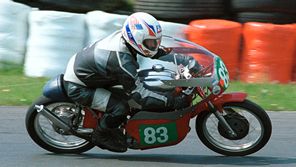
More traditional sprints are run by the National Sprint Association and the "Straightliners" organization. Their events are run in straight lines with the emphasis being purely on acceleration.
By contrast, in many of the classic sprints the fastest, or most powerful, machine will not necessarily win. To succeed in a classic sprint, the bike needs to stop and handle too.
This means that you don't have to spend a fortune on a super-duper replica Grand Prix racer. I suppose something in the region of £1,000 will buy a competitive C15 BSA which can be raced all season for only a few pounds. Look in "Old Bike Mart" where there is always a selection of machines for sale.
Sammy Green gets his lovely little 175 Honda off the line at Hoghton Tower
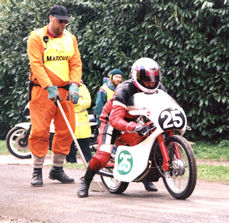
What Machines Can be Used?
Every club has different eligibility rules but they roughly follow these guidelines:
1) Pre-War - Made before 1939
2) Post-War to 1958
3) Post War 1958-1973 - except that some clubs get upset with two strokes and so make the two-stroke class for machines made before 1968.
It is a good idea to ring some of the clubs who organise meetings near you to see how they feel about a bike you might want to race. In particular, some organisers become stressed by early Japanese classics but are very liberal with their interpretation of what constitutes a European bike made before 1973.
It also depends what you like and have available. Personally, I like to race big, powerful bikes which cover up my riding mistakes. I have always been involved with T500 Suzukis and so I race these bikes. You might have had pre-unit Triumphs all your life, and have enough bits to make a complete bike, so the sensible thing would be to race in the early post-war class.
The key thing is to race something you like and with which you feel comfortable. Even if you win, no-one except your wife and dog are going to be even the slightest degree interested so you might as well race something which brings a smile to your face.
BSA engined grass track bikes make a good basis for a classic sprint machine
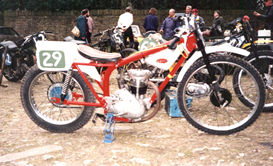
Competitive Machines:
This is a rather tricky area but these are some of the bikes I know do well in the classic sprints in which I ride. Please don't get upset if your bike is not included. The truth is that you can make any bike win at a classic sprint if you want to spend enough money on it. These bikes are the easy options:
Pre-War - MOV Velocettes always seem to be quick, reliable and affordable. Exotics like Pre-War cammy Nortons and ohc KTT Velocettes are wonderful - if you can afford them.
Post-War - Triumphs, in both 500cc and 650cc capacity, are always a good bet. They are fast and reliable and can be tuned to ridiculously high levels. They are also easy to work on and there are plenty of bits available. Avoid things like Vincents or ohc Nortons unless you are rich or have specialist knowledge - and preferably both.
250 Classic - This is an extremely popular class because there are so many affordable bikes available. The 5 speed Royal Enfields can be made to fly as can BSA C15s and B25s. Spares are readily available and cheap for the BSAs. If you fancy an ohc bike, there are lots of race tuned Ducatis available and apparently the bikes to have are all based on the late Ducati Mach 1s. These Ducatis look really nice and go well.
Competitive 2 strokes are not so straightforward. The dominant machine is the six speed Suzuki T20 but a good one is not easy to ride and will be demanding in terms of maintenance.
350 Classic - Ducatis are very good in this class but the biggest bang for your pound coin will come from a converted K4 Honda road bike. However, it should be said that these bikes vary tremendously in their quality. Some K4s are truly stunning and genuine 135mph missiles. However, others are most definitely not. Seek help from a club like the Classic Racing Motorcycle Club (click on highlighted name to reach their web site) or the VJMC (click on highlighted name to reach their web site) for more detailed information. If you are not really into K4s, do ask for advice before you buy.
500 and Unlimited Classic Classes - In the 500 class, I like Suzuki T500s but, since I race one, I would say that. The big Suzukis are fast, reliable and cheap but, if you are a beginner, you should be aware that these are big, powerful machines which will bite you if things go wrong. 500 Hondas are nice too as are BSA B50s. Once more Triumphs are very competitive.
There are also some extremely quick Jawa engined machines about and, since these motors were designed for racing, they will take an enormous amount of tuning without going bang.
Early Honda 4s - both 350s and 500s - can be made into stunning race bikes
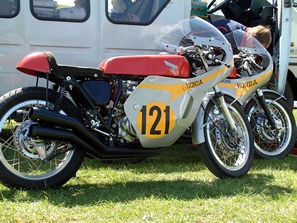
Early Honda 4s have always been popular in American classic racing and now they are beginning to attract a following in Britain too. The engine is strong, bits are freely available and they go very well too. If you fancy being a Jim Redman or Mike Hailwood replica then this is the bike for you.
Unless you have a strong background in exotic machines, avoid expensive specialist bikes like Keith Heckles' lovely Manx Norton shown here
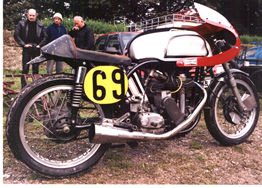
It's Triumphs again in the Unlimited Class and once more I would suggest that this is not a class for a beginner. A good 750 Bonneville will manage 90mph at a twisty classic sprint and whilst that might not sound very fast in terms of motorway speeds, it is dramatically quick on a 12 foot wide strip of bumpy tarmac.
Big man on a big bike. Commando fan Ben Davies ready for blast off on his 850 Norton
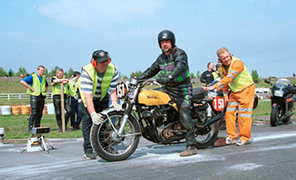
Having said that, a lot of riders are committed to Bonnevilles, Tridents, Norton Commandos and Dominators. As I said earlier if you have a pressing reason to race one of these models then do so - but don't go and buy one with the express intention of winning because there are a lot of fast bikes and seriously competitive riders in this class.
Motocross bikes always go well in classic sprints. Here's a lovely "bolt-up" 250 Husqvarna about to launch off the line at Hoghton Tower
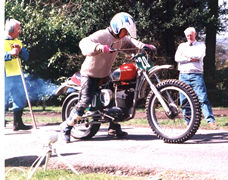
Last but not least, if you really fancy your chance as the last of the great British heroes buy a 900 Weslake motor and pop it into a Seeley frame. Brand-new, this set-up will cost a serious £10,000 but you will get a chance to do a 100mph through sheep poo and over pot holes. Personally, I wouldn't if I had the money but you might. Constipation will be guaranteed to be a thing of the past!
Race Preparation:
The key thing is to make the bike safe. The speed can come later but to begin with, make sure that you are not going to get hurt. Start with the wheels and replace the wheel bearings. Make sure that the spokes are in good condition and that the rims are true on the hubs. Do spend money on a pair of Avon racing tyres. These are not cheap - about £200 a pair - but are so sticky that they are a tremendous aid to safety and performance.
Clean up the brake linings whilst the wheels are dismantled. You will need really efficient brakes at many of the best classic sprints.
Replace the steering head bearings and swinging arm bushes, if you have a pivoted rear fork bike, and check that the wheels are in line. An amazing number of race bikes have the rear wheel running at an angle to the front and this destroys the handling.
Check that there are no cracks in the frame.
When all else fails, you can always try begging the thing to run. Surprisingly, it often works!
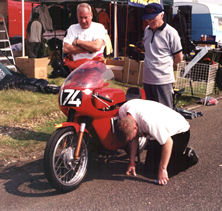
Next, check that the petrol and oil tanks are not rubbing on the frame. If they are, they will definitely split when the bike is raced and vibration is at its peak.
Although demands vary from club to club, it is a good idea to wire up any drain plugs and wire the oil feed to the supply tank. Some clubs get really uptight about this and the last thing you want at a relaxing day out is an argument with a scrutineer. Wiring means drilling a very small hole in the drain plug and then twisting some wire though it and securing the ends on to the bike's frame. The wire stops the nut, or plug, from coming unscrewed.
Dismantle the carburettor entirely and take it along to a friendly jewellers. If you ask them nicely, they will dunk it in their jewellery cleaning bath and an hour later it will come up like new, both inside and out. If the carburetor slide and needle are not in perfect condition, then replace them. The slide should now go fully closed just on the strength of the return spring.
Clean the throttle assembly and remove all grease. Next, rebuild it and and lubricate the throttle assembly with an extremely thin lubricant like WD40. Fit a new throttle cable and lubricate this with WD40 too. Then make sure that the route to the carburettor is as smooth as possible so that the throttle closes shut instantly just on the pressure of the return spring. Don't forget to give a squirt of lubricant on the handlebar too so that the throttle turns smoothly against against the bar.
Make sure that the throttle cable doesn't pull tight on full steering lock or get in the way of the handlebars. If you do get into a tangle, the last thing you need is the added thrill of the throttle snatching open on full lock!
Make sure that the throttle drum is tightly pinched on the 'bar and the clutch side handlebar grip is glued to the 'bar. Again, it is no fun to have a "moment" with the bike only to find that the throttle assembly has come off in your hand!
Lightly lubricate the rear chain and then check the tension. Once more, sprinting provides plenty of excitement without having to contend with an excess of chain grease on the tyre.
Check that nothing is falling off the bike. Even the most fastidious racer can make a mistake so run the spanners over all the bike and check that everything is tight. At this last stage, don't take any 'phone calls or break for your tea. I still remembering answering a critical 'phone call from an American client during my final check and forgetting to tighten the rear wheel nut on my BSA racer. This could have been a seriously nasty mistake had the scrutineer not found the error. Take the last ten minutes just to go over the bike thoughtfully without being disturbed.
Chris Herriman fines tunes his 125 Honda with a big hammer - thus demonstrating the skill of true paddock technician! Better to do the mechanical bits at home...
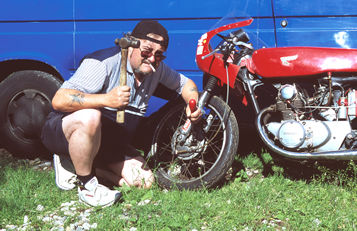
Finally, get the bike clean and tidy. I don't mean concours winning polish but clean enough for it to be examined without the scrutineer catching some lethal disease. I think that this is showing basic good manners to the person inspecting the bike.
Silencing:
This is a sore point with a lot of traditional sprinters who feel that it is a personal insult to expect their bike to be silenced. The bottom line is that anyone who races an unsilenced bike is living on borrowed time. Everyone will race silenced bikes in a few years and that's a fact. This being the case, start out by silencing your bike from day one.
The current noise level is 105dba and this is not ridiculously restrictive. Any classic can be silenced to 105dba without a huge amount of effort so there is no excuse.
If we don't silence our own bikes, then someone else will do it for us by law - and you can guarantee it won't be at the liberal and sensible 105dba limit either.
Having said this, there has been a really strange, and completely unforeseen, reaction to unsilenced bikes in the last two years. In 2000, I was absolutely certain that it would have been impossible to run a bike anywhere in Europe by 2004 without silencing but suddenly there is an unexpected tolerance being shown towards old bikes. I can't think of a logical reason why this should be except that in a society where nothing - from your computer to a modern Superbike - is anything other than whisper quiet perhaps there is a craving for something with an identity. And nothing, but nothing, sounds nicer than a classic race bike on full song.
I don't know how long this tolerance to racing bikes sounding authentic will last - it might just be an aberrant blip on the way to conformity - but it's worth having a spare, unsilenced system for your machine and, if you have the opportunity, you can run the bike sounding just as it did when your Dad was a lad.
Andrew Bennett in full flow on his beautiful 1934 600cc Norton. Very period and authentic - but note the silencer. Bikes now have to be quiet at many circuits.
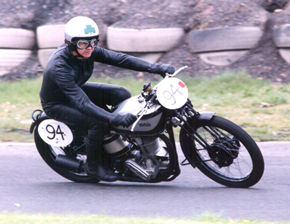
Clothing:
You will need full leathers, leather boots, gloves and a helmet in good condition. Crashes are rare at classic sprints - but not unknown. When I threw Dave Degens' Triton up the road at the 1999 Thundersprint I was very glad that I was wearing good quality race leathers and a £450 Arai. When you hit the deck, it is far too late to change your mind about those cheapo leathers you bought on special offer. Buy the best you can afford.
Kevin
Theobold having a big go on his Honda 50. Kevin is a super safe rider but is still
wearing top quality protective gear.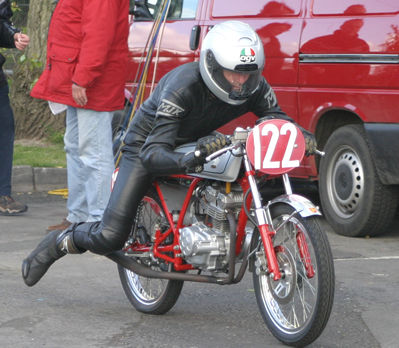
A Few General Tips:
1) Most important, enjoy yourself. You're not there to win but to have a day's fun. Truly, no-one cares whether you win or are last. Classic sprinters are not status conscious. Relax and enjoy. You ought to have more sense than spend good money on an old racing bike in the first place so accept that you are one spanner short of a toolbox and have a good time.
2) Do your bike preparation at home. It's always better to work late and finish your bike than arrive at the meeting and start last minute jobs. It doesn't make for a good day out and it's not a sensible idea from a safety point of view either.
3) Arrive early. This comes as total hypocrisy from me since I am late for absolutely everything but the smart thing is to arrive early and then relax.
4) Always walk the course. The funny thing is that the fastest riders, with the most experience and therefore the least need to walk the course, are always the ones you find going over the route inch by inch. Conversely, the slowest riders are the ones you never see walking the course: there's a lesson to be drawn from this.
Concentration is everything!
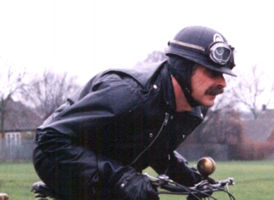
5) Try to find a quiet place and ride the track in your head. You should try to work out what you are going to do with the bike before you get near the track. Close your eyes and then ride it in your head. Mental crashes are a lot less painful than real ones so you can experiment in safety.
Ride smoothly. If you don't, things can get very lively at classic sprints!
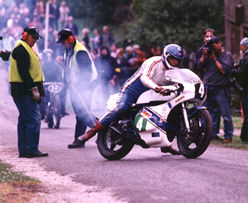
6) Ride smoothly. Don't push yourself or the bike. Ride well within your comfort zone, and you will be faster and safer than if you are all arms and legs and on and off the throttle.
7) Practice means just that: "practice". Use your practice runs to learn the course and get the best from the bike. There are no prizes for coming first in practice.
8) Ask for advice. Don't be shy or frightened that you will look an idiot or say something inappropriate. Classic sprinting is not MotoGP so ask and everyone will be delighted to help.
9) Go and watch other riders compete. Every rider can learn from watching what the opposition is doing.
10) Do break as many of the accepted rules for athletes as possible. Eat humungous meals at every opportunity, high cholesterol fry ups are the best, drink loads of sweet coffee, develop a huge belly which won't fit into your leathers, gossip non-stop and enjoy life!
Some Good Meetings:
I have ridden at most, but not all, of these events. The ones I haven't ridden have been recommended by other riders. If you know of a really good meeting which is not mentioned, e-mail me at frank@thundersprint.com and I'll include the information.
Barbon:
Barbon's start is in one of the most beautiful sections of countryside in the world - and offers lots of grip!
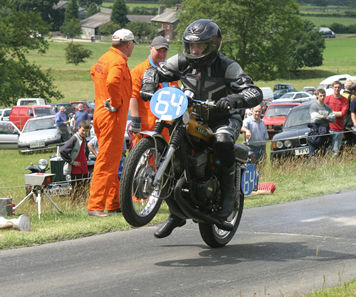 Words
can't describe just how good this event is. Strictly speaking, Barbon is a hillclimb
and, if you can get an entry, is one of the "must-do" events in the
calendar. The course winds up the side of a hill and the highlight for me is a
bowel loosening flat-out left-hander which has a blind approach. I try and try
but I still get scared and roll it off on this bend. Seeing the penalty for getting
it wrong, maybe this is not such a bad thing!
Words
can't describe just how good this event is. Strictly speaking, Barbon is a hillclimb
and, if you can get an entry, is one of the "must-do" events in the
calendar. The course winds up the side of a hill and the highlight for me is a
bowel loosening flat-out left-hander which has a blind approach. I try and try
but I still get scared and roll it off on this bend. Seeing the penalty for getting
it wrong, maybe this is not such a bad thing!
There is a class for vintage bikes but none for classics so if you have a post-war machine you have to ride against the modern bikes which means that there is no chance of taking home a trophy. Truly, the most spectacular course I have ever ridden in a sprint.
Contact: Percy Duff 01539 727 828
Blackpool Sprint:
A straight-line sprint run under the seawall at the northern edge of Blackpool. Not a meeting that does anything for me but very well organised by the Fleetwood and District MC and attracting a big entry. A full quarter mile with a maximum speed reading at the end, which is always interesting. Lots of different classes and dozens of trophies to win. Held late July.
Contact: B. Anderton 01253 875444
Castle Ashby:
This is a VMCC run event which has become very popular in just two years. A 220 yards course with, I am told, an interesting kink midway. I have been informed unofficially that there are some problems with this event so it is particularly important to check whether it is still being run.
Contact: The Vintage Motorcycle Club, Allen House, Wetmore Road, Burton-on-Trent, Staffs. Tel. 01283 540577
Carnaby:
In the normal run of things, you wouldn't think that riding round a flat airfield would be much fun but Peter Hillaby has done a wonderful job with Carnaby. Using natural features, like shrubbery, Peter has plotted what looks and feels like a "natural" track with the minimum of traffic cones. The surface is superb and this makes for a fast course with everything from tight hairpins to some flat out straights and fast corners. It's long too, at nearly a mile, but it's very busy with no rest for the rider.
As well as providing a big thrill for experts, Carnaby is good for less experienced competitors because everything is so big and wide with lots of run off space. If you wanted to move up from basic classic sprints to serious events, Carnaby is the one to do first because it's a safe way to get used to high speeds.
The organization is typical Auto 66 Club - no frills but friendly, slick and efficient.
Contact: Peter Hillaby 01377 254 727
Catterick:
This was a new event for 2002 and has a lot going for it. However, the course is very challenging with a series of tight corners and a steep climb. There is a very real potential to end up in a bin sack at this event so it does need a lot of thought and respect.
The paddock is excellent, with lots of room, and the setting wonderful, in a wood just on the edge of the huge Catterick Barracks complex. Definitely one to do but if you are new to hillclimbing, approach this course with a high degree of care. Also, your bike needs to be in top condition in terms of brakes and handling.
Contact: Ernie Crust 01642 287 164
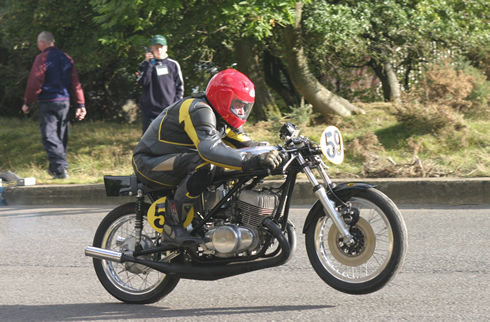
Apologies for having two Frank Melling pictures in this guide but the shot shows a good example of a text book hillclimb start. The picture was taken at Catterick where the start line is uphill and so is particularly tricky.
Note that the front wheel is just hovering off the ground - but no-where near a time consuming wheelie - and there is no wheelspin. The throttle is wound right open and the bike is being balanced just on the clutch: more clutch and the acceleration eases off and stops wheelies; less clutch and the front end goes light and/or wheelspin occurs.
Done like this, the starts are clean and fast - they also feel really effortless. I just wish I could do them on every run! If you can find somewhere to practice starts before actually entering a sprint, the time spent will be invaluable. Starts are everything in sprints.
The picture is by Elizabeth Melling - aged 10 - who is a keen sprint fan and something of an aficionado of good starts - as I am reminded when I get them wrong!
Dalby Forest:
The fastest classic sprinters are really fast. Here's Jason Caunce doing his normal job of destroying the opposition
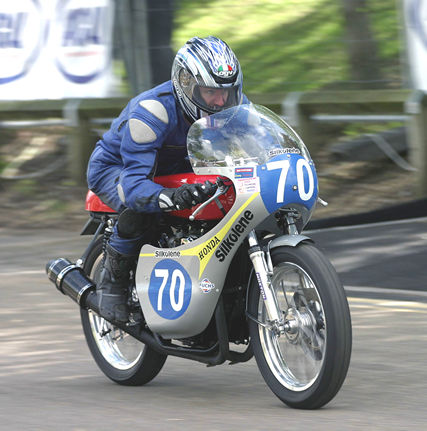
This event is a cracker. In dry weather, it's incredibly fast and the bike needs to be geared for its absolute maximum speed. My Seeley-Suzuki was pulling a solid 130mph at the finish - and I still finished second!
The course is over 3/4 mile long and I can nearly, but not quite, ride it flat out. On the course map, it looks straight - but on a decent 500 it's a series of curves of differing radii and a seriously big thrill if you're going to nail it all the way up.
The paddock is cramped but the setting is very beautiful and makes a lovely day out in Autumn. There is also a Dalby event very late in the year and in the pouring rain, it is truly grim! I'm too much of a girlie to ride Dalby in a blizzard again.
Contact: Peter Hillaby 01377 254 727
Hoghton Tower:
Another 220 yard course but this time run up the drive of Sir Bernard de Hoghton's castle, near Blackburn in Lancashire. Straightline course but harder to ride than would first appear because of the camber on the driveway. A very different sort of meeting and worth riding at least once just for the experience. Held in late April.
Contact: 01282 694140
Below is the Hoghton Tower course. It's always worth doing at least once, just for the experience of racing in someone's front garden.
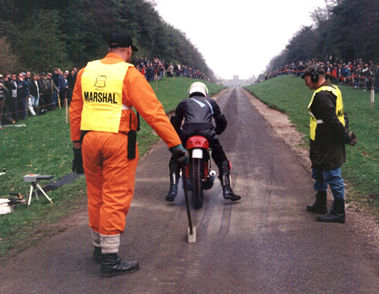
Lyme Park:
A 220 yard course in a lovely setting in Lyme Park, which is near Stockport on the southern edge of Manchester. A bit on the short side. Easy to ride with plenty of run-off. Excellent for beginners. Held in late July. Unfortunately, I understand that this is another event whose future is unsure after the retirement of Colin Bell, who was the driving force behind the meeting. Check with the VMCC to confirm what is happening in 2004.
Contact: The Vintage Motorcycle Club, Allen House, Wetmore Road, Burton-on-Trent, Staffs. Tel. 01283 540577
North Weald Sprint:
I have never ridden at this event but everyone I speak to who has ridden there praises the slick organization, friendly atmosphere and vast number of bikes entered. The meeting is held on an airfield and is a straight line event attracting an entry of hundreds.
Contact: Terry Homan 01255 508120
Ormesby Hall:
Run by the Middlesborough and District Motor Club, Ormesby is a cracking event consisting of a 440 yard course with a lovely left/right chicane immediately in front of a stand of huge trees. The knack is to aim for the middle tree and, just as you are about to have a one to one with Saint Peter, peel off left. You really do need to concentrate hard at this point! It's a particularly nice event because it is very simple to ride slowly but extremely to hard if you want to go seriously fast. The very brave can ride the whole course without ever shutting off. I've not got the bottle!
Held in late May.
Ernie Crust and his team have altered the eligibility so later classics were banned because of their high top speeds. Now, you need a pre 1967 bike to enter.
Contact: Ernie Crust 01642 287 164
Saltburn:
This is Ernie Crust's other event and one which I just love. It starts in a Council run car-park, alongside the sea at Saltburn. The course then goes over a bridge and up a steep hill to finish in a housing estate. It's really tricky to ride and there's a tremendous sense of satisfaction if you can get it right. I haven't managed one completely good run in six years of riding there - but it's addictive trying. Held in early September.
Contact: Ernie Crust: 01642 287 164
The author of this guide, Frank Melling, in action on the Crooks-Suzuki at the Saltburn sprint
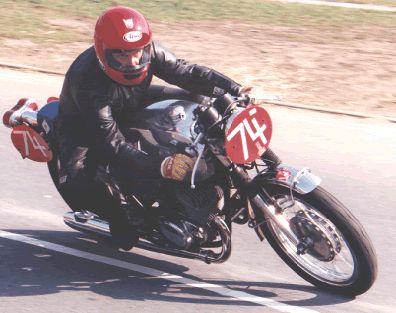
Scarborough Hill Climb:
There are usually two or three hill climbs held at the Oliver's Mount circuit each year but sadly they are often run mid-week which limits the entry somewhat. The course is superb - really, as good as you can get. The track starts off in the paddock and then joins the road racing circuit and finishes up on the top of Oliver's Mount . It is difficult to ride quickly and very satisfying when you get it right. I particularly like this track because it is hard on the bike and rider. Make sure that you have two extremely functional brakes when you go out at Scarborough - you'll need them. Newcomers should think very carefully before nailing the throttle: this circuit demands respect!
Contact: Peter Hillaby 01377 254 727
The Thundersprint:
If you want Classic Sprinting with bells and whistles the Thundersprint is the place to be. The Thundersprint is show business and bike racing combined and is unique. Beginners are welcome but you need to be quick with your entry because we're always hugely oversubscribed. Entries are usually full up a few days after the previous year's event and priority is given to riders who compete every year.
The best way to get an entry is to take part in the previous year's Cavalcade Click here for an entry form. Each year, some riders drop out because of personal reasons and reserve entries are taken from Cavalcade entrants.
For name dropping, the Thundersprint can't be beaten. Last year, there were two world champions entered plus a big international entry. Held in the second week in May.
Some Useful Contact Numbers:
ACU (www.acu.org.uk)- There are more ACU sanctioned events than those of any other organization. Contact ACU headquarters for information on sprints near you.
Auto 66 (Auto 66) The club which controls the Scarborough twisty sprints and hill climbs.
NSA (www.sprinting.org.uk)- The National Sprint Association runs an immense amount of sprints all over the country - but, as far as I know, they are all straight line events. Very professional set-up and an excellent web site.
NHCA - The National Hill Climb Association (www.nhca.co.uk) organises, not surprisingly, hill climbs. The majority of their events are in the south of England. Very nice people and informal racing.
Straightliners (www.straightliners.co.uk)- This is a commercial organization which runs lots of events which include classes for almost everything with two wheels. It specialises in "run what you brung" meetings with the emphasis on informality.
Contact us at:info@thundersprint.com
or 'phone us on 01928 740 498
